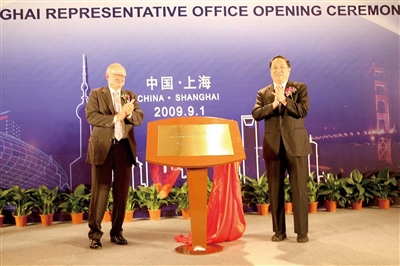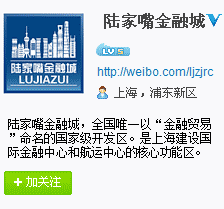Silicon Valley Bank arrives
|
|||||||||
Updated: 2012-10-18
Technological revolution cannot ignore the importance of financial strength. To meet the demands of technical enterprises, the science and technological bank has emerged.

Silicon Valley Bank is typical of innovative financial models that have achieved success in America. It desperately wants to reproduce this model in China.
In mid-August, Shanghai Pudong Development Bank (PDB) and the United States Silicon Valley Bank (SVB) jointly established the first domestic joint-venture technological bank under an independent legal entity, PDB Silicon Valley Bank, in Shanghai.
However, PDB Silicon Valley Bank is only allowed to engage in deposits and loans of foreign currencies to enterprises. A renminbi business license may be granted after three years. In view of the huge difference between the Chinese and American financial environment, the bank may face difficulties expanding in the region.
Regression of RMB License
Started in the United States, the technological bank was commonly considered a risk bank because it targeted mainly at risk investments and its investors. Providing hi-tech enterprises with financial services is high risk. The banking institutions are defined as technological banks that can afford to offer financing services to hi-tech innovative enterprises
As the pioneer of financial industry innovation at home, PDB Silicon Valley Bank has been followed significantly. However, this joint-venture bank may find it difficult to expand before approval of the renminbi license.
Founded by PDB and America Silicon Valley Bank via a 50 percent joint venture, PDB Silicon Valley Bank is dedicated to serving technologically innovative enterprises. Its registered capital totals 1 billion yuan. Fu Jianhua, former vice president and governor of PDB, serves as the president and Ken Wilcox, president of American Silicon Valley Bank, as the governor.
Similar to the United States business model for Silicon Valley Bank, the joint venture bank is temporarily available to offer deposits and loans for technological enterprises, but not individual business.
This was never the goal of PDB Silicon Valley Bank. According to high-level management at Silicon Valley Bank in a special interview, the innovative enterprises in the Chinese mainland are threatened by a huge demand for renminbi products and services. After obtaining USD loans, it may take three to six months for innovative enterprises to pass through the period of exchange settlement. This will severely impact those enterprises in urgent need of money.
Ken Wilcox expressed his concerns. This is PDB Silicon Valley Bank’s largest barrier at the moment, he said. What he desires most is to obtain the renminbi license, but the process may take up to three years.
According to relevant regulations from the competent authority, foreign-funded banks are only allowed to engage in foreign currency business during their initial three years of operation, namely, they cannot issue deposits and loans for renminbi. Therefore, PDB Silicon Valley Bank will develop traditional deposits and loans and credit services catering to innovative technological enterprises during its preliminary stage. Meanwhile, it will make a priority of financing hi-tech enterprises in Shanghai and surrounding areas in order to cautiously develop a domestic cluster of hi-tech industries.
Because of the inability to operate in renminbi, the joint venture bank will turn to PDB. Ken Wilcox revealed that the new bank has entered an independent Agreement of Cooperation respectively with these two shareholders, explicitly stating the fields of cooperation.
Finalized after ups and downs
PDB Silicon Valley Bank was finally established after many ups and downs, including years of exploration and nine months of preparation.
When interviewed, Ken Wilcox recalled his experience visiting China many years ago. At that time, he was deeply touched by the vigorous atmosphere for technological enterprises here. He detected a huge opportunity in the domestic market in science and technology finance. Thus, American Silicon Valley Bank set up its first representative office in Huaihai Road, Shanghai, in 2005 with Ken Wilcox serving as chairman.
Without the bank license, Silicon Valley Bank was only able to offer off-shore USD business for offshore registered Chinese technological enterprises. It mainly provided consultation services for American clients in China.
In 2007, Ken Wilcox met Chen Anjie, then-secretary of the Yangpu District Party Committee, Shanghai. He recommended the successful model of Silicon Valley Bank to leaders of Shanghai, which brought significant attention to Ken’s company. Later, he formed ties with Shanghai-headquartered Pudong Development Bank.
He continued to wait for business license approval in the following four years. During that period, he became active in the domestic financial industry. For instance, he introduced the experiences of Silicon Valley Bank at the Lujiazui Forum, sharing lessons in serving small and medium-sized enterprises.
The joint venture bank finally obtained approval from the China Banking Regulatory Commission for establishment in October 2011. After passing examination in June 2012, the Shanghai Banking Regulatory Commission officially approved the bank to open by late July.
Tu Guangshao, vice-mayor of Shanghai, attended the opening ceremony of PDB Silicon Valley Bank. Shanghai has hundreds of banks of different scale; PDB Silicon Valley Bank, with a registered capital of 1 billion yuan, is just a drop in the bucket. But its business model can promote technological innovation and cater to the demands of Shanghai, so it has attracted significant attention.
According to Ken, the Shanghai Representative Office of American Silicon Valley Bank will remain effective after the establishment of the joint venture bank. More than 300 cooperative institutions accumulated before can be transformed into clients of Shanghai Pudong Development Bank, if desired. If only engaging in offshore USD business, clients can keep cooperative ties with the representative office. Among these 300 institutions, half of them are technological enterprises, while the other half are risk investment institutions.
Unaccustomed to a new place?
Silicon Valley Bank’s success in the America market has allowed it to stay close to venture capital firms and maintain unique post-credit management methods.
Silicon Valley Bank mainly adopted three business models. First, promote risk investment and meet technological corporate client demand for low cost deposits, allowing the bank to make a profit through interest margins from loans to hi-tech enterprises in Series A financing. Second, make investment returns by offering clients diverse investment portfolios. Third, achieve income from intermediate business by offering trade financing and other financial services to technological enterprises.
Apart from Silicon Valley Bank, the group also set up Silicon Valley Capital, which is responsible for direct investment business. The investors include risk investment companies and technological innovative enterprises. It is reported that Silicon Valley Capital has started operations in the Chinese mainland. It is capable of supporting renminbi investment.
In this way, could they reproduce the financial model of Silicon Valley Bank in China? So far, the joint venture bank may have issues with the new environment in its primary stage.
There are three possible issues the bank may face. First, the joint venture bank formulated its unique risk management system based on the highly developed risk investment in the United States. Although risk investments emerged in China, it is still underdeveloped. Second, as a leader in the segment market, it can avoid competition with large banks. This competitive edge is mainly attributable to the highly-developed American financial system. But the domestic banking models of operations are uniform. Third, the imbalance of hi-tech enterprise information cannot be resolved, and the high risks burdened by the technological bank hardly claimed for adequate risk compensation.
Furthermore, PDB Silicon Valley Bank is exposed to competition from the domestic banking industry. Some share-holding banks and trading firms have established technological bank branches, or begun small and medium departments of technological enterprises.
Taking Shanghai as an example: Shanghai has three total operation centers for small-sized enterprises operating with a license currently. These include Pudong Development Bank, Minsheng Bank and the Bank of Shanghai. Zhejiang Tailong Commercial Bank, Zhejiang Mintai Commercial Bank and Zhejiang Chouzhou Commercial Bank have also set up special branches for micro-enterprises in Shanghai.
In fact, Pudong Development Bank has always been attracted to the financial aspects of technology enterprises. PDB Shanghai Branch established its Technological Enterprise Service Center in August 2009, specializing in marketing promotion, corporate planning management and credit granting approval for financial and technological businesses. Meanwhile, special institutes have been respectively established in Zhangjiang Area, Pudong New Area and Yangpu Knowledge and Innovation Community, aiming to become a pilot for financial and technological business.
Fu Jianhua, chairman of PDB Silicon Valley Bank, had great expectations for the joint venture bank. He said, the bank hopes to become the best choice for medium and small sized technological enterprises and entrepreneurs with its unique financial service concept, differentiated objective of market position and efficient business models.
As the leading domestically recognized technological bank, it will take time before PDB Silicon Valley Bank can achieve more in China than the United States.






